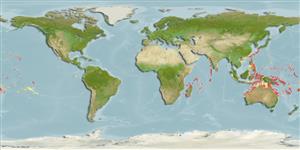Actinopterygii (ray-finned fishes) >
Anguilliformes (Eels and morays) >
Muraenidae (Moray eels) > Muraeninae
Etymology: Gymnothorax: Greek, gymnos = naked + Greek, thorax, -akos = breast (Ref. 45335); breedeni: Named for Vic. E, Breeden.. More on author: McCosker, Randall.
Environment / Climate / Range
Ecology
Marine; reef-associated; depth range 4 - 40 m (Ref. 30874), usually ? - 20 m (Ref. 30404). Tropical, preferred ?
Indo-Pacific: widespread in the Indian Ocean, ranging to some oceanic locations in the Pacific.
Size / Weight / Age
Maturity: Lm ? range ? - ? cm
Max length : 100.0 cm TL male/unsexed; (Ref. 30874)
Short description
Morphology | Morphometrics
Vertebrae: 128 - 131. Distinctive black patch mark below eye (Ref. 30404). Body brown, speckled darker; dark anus and gill opening (Ref. 3257).
Inhabits clear seaward reefs of oceanic islands to a depth over 25 m (Ref. 9710). Common on reef walls and steep slopes with holes (Ref. 30404). Inhabits porous coral rock which it shares with swarms of anthiases (Ref. 37816). Feeds on fishes and octopi (Ref. 89972). Territorial and will bite when provoked (Ref. 30404). Minimum depth reported taken from Ref. 9710.
Life cycle and mating behavior
Maturity | Reproduction | Spawning | Eggs | Fecundity | Larvae
Castle, P.H.J. and J.E. McCosker, 1986. Muraenidae. p. 165-176. In M.M. Smith and P.C. Heemstra (eds.) Smiths' sea fishes. Springer-Verlag, Berlin. (Ref. 3257)
IUCN Red List Status (Ref. 115185)
CITES (Ref. 94142)
Not Evaluated
Threat to humans
Traumatogenic (Ref. 30404)
Human uses
More information
Common namesSynonymsMetabolismPredatorsEcotoxicologyReproductionMaturitySpawningFecundityEggsEgg development
ReferencesAquacultureAquaculture profileStrainsGeneticsAllele frequenciesHeritabilityDiseasesProcessingMass conversion
Tools
Special reports
Download XML
Internet sources
